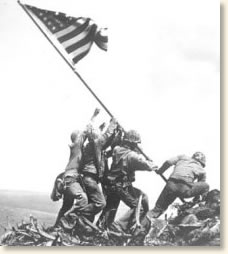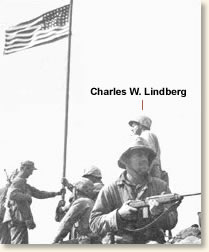To our veterans: Salute !!!!!
 |
| The 2nd flag-raising atop Mt. Suribachi Feb. 23, 1945 |
The First Flag-Raising
Scott Tank sent us this eyewitness account of Cpl. Charles W. Lindberg, a friend and the last surviving member of the team that raised the first flag on the crest of Mt. Suribachi. Scott asked that we share Mr. Lindberg's story with you - we are honored to do so. Thank you Scott for sending us this account, and thank you Mr. Lindberg for the sacrifices you made during that bloody nightmare called Iwo Jima:
It was the job of the 28th Regiment, 5th Division, to capture Mount Suribachi. They reached the base of the mountain on the afternoon of February 21, and by nightfall the next day the Marines had almost completely surrounded it. As part of that Marine group, 24-year-old Corporal Charles Lindberg, a combat veteran of the Guadalcanal and the Bougainville campaign, watched the intense bombardment of Iwo Jima and realized that the landing at Red Beach One would be anything but easy. "The Japs had the whole beach zeroed in. Most of the fire was coming from Suribachi," he recalled. Surrounding Mount Suribachi were cliffs, tunnels, mines, booby traps, and ravines. The hostile terrain proved to be as tough an enemy as the Japanese who were firmly entrenched on the mountain. At 8 a.m. on February 23, a patrol of 40 men from 3rd Platoon, E Company, 2nd Battalion, 28th Marines, led by 1LT Lieutenant Harold G. Schrier, assembled at the base of Mount Suribachi. The platoon's mission was to take the crater of Suribachi's peak and raise the U.S. flag. As a member of the first combat patrol to scale Mount Suribachi, Cpl Lindberg took his 72-pound flamethrower and started the tortuous climb up the rough terrain to the top.
As they reached the top, the patrol members took positions around the crater watching for pockets of enemy resistance as other members of the patrol looked for something on which to raise the flag. Present at the crest were six Marines of a 40-man patrol. They were 1LT Lieutenant Schrier, Sergeant Thomas, Sergeant Hansen, Private First Class Charlo, Private First Class Michels, and Corporal Charles W. Lindberg. 
Raising the 1st flag under enemy fire
At approximately 10:20 a.m., the flag was hoisted on a steel pipe above the island. The sight of the small American flag flying from atop Mount Suribachi thrilled men all over the island. And for the first time during WWII, an American flag was flying above what was considered traditional Japanese territory. This symbol of victory sent a wave of strength to the battle-weary fighting men below, and struck a further mental blow against the island's defenders.
Marine Corps photographer Sergeant Lou Lowery captured this first flag raising on film just as the enemy hurled a grenade in his direction. Dodging the grenade, Lowery hurled his body over the edge of the crater and tumbled 50 feet. His camera lens was shattered, but he and his film were safe.
As Cpl Lindberg would later remark, "Suribachi was easy to take; it was getting there that was so hard!" Of the 40-man patrol, thirty-six were killed or wounded in later fighting on Iwo Jima including Lindberg himself who would be shot through the stomach and arm a week later on 1 March, 1945. For his heroism Lindberg would receive the Purple Heart and Silver Star Medal with the citation reading in part:
"Repeatedly exposing himself to hostile grenades and machine-gun fire in order that he might reach and neutralize enemy pill-boxes at the base of Mount Suribachi, Corporal Lindberg courageously approached within ten or fifteen yards of the emplacements before discharging his weapon, thereby assuring the annihilation of the enemy and the successful completion of this platoon's mission. While engaged in an attack on hostile cave positions on March 1, he fearlessly exposed himself to accurate enemy fire and was subsequently wounded and evacuated."
No comments:
Post a Comment